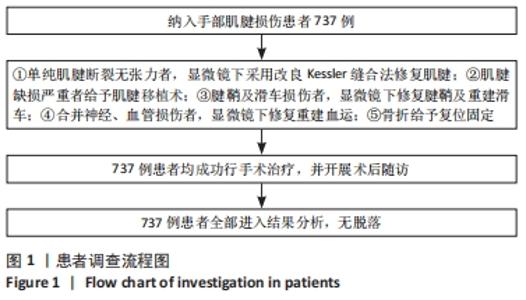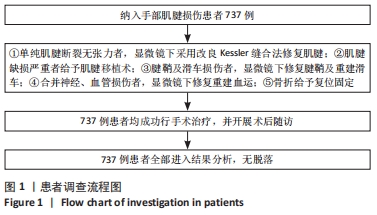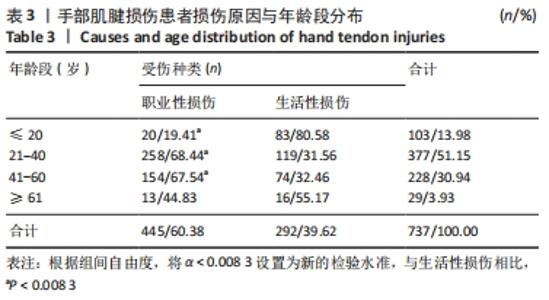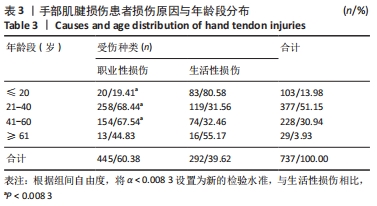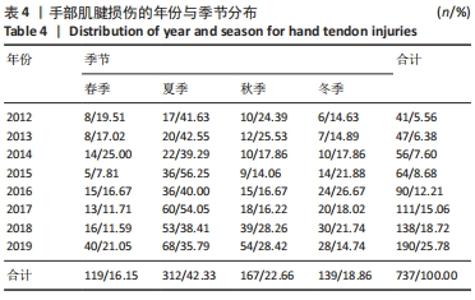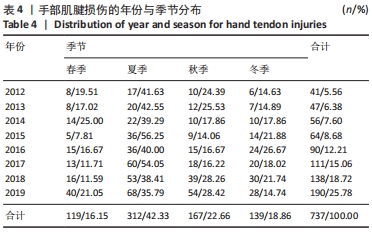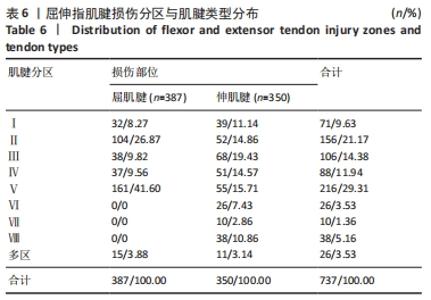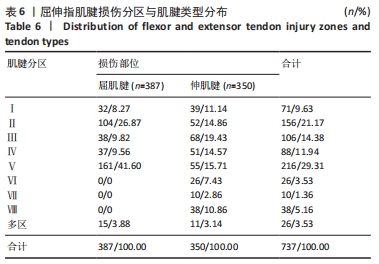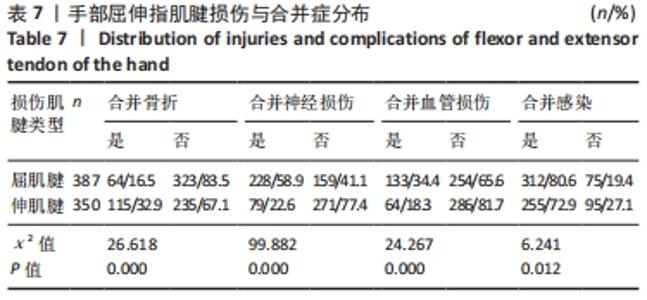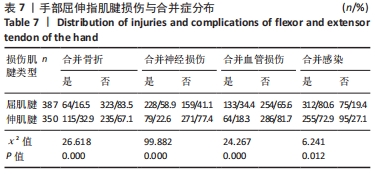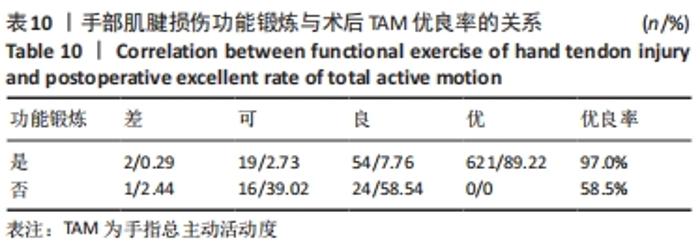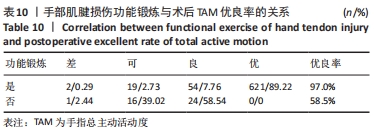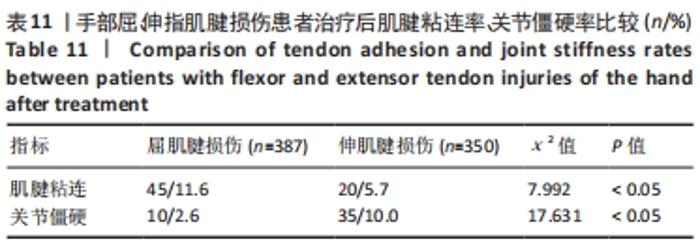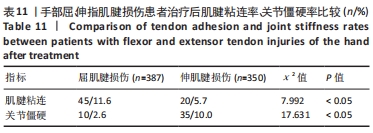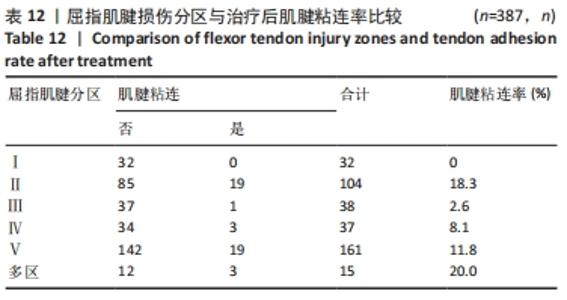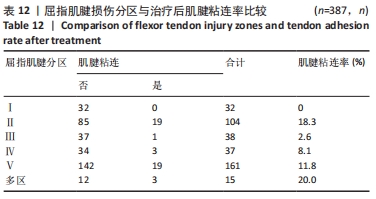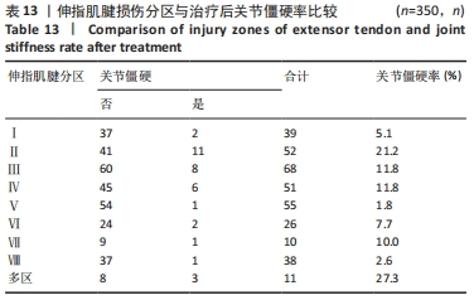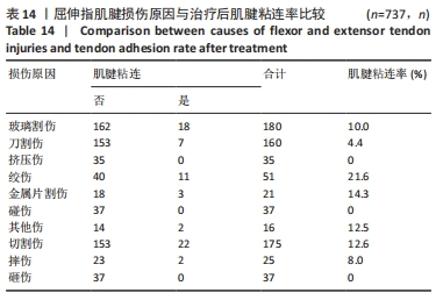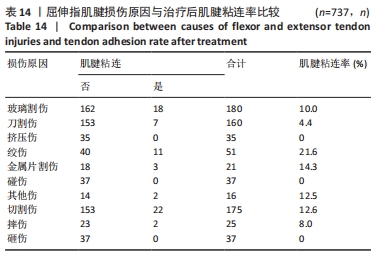Chinese Journal of Tissue Engineering Research ›› 2022, Vol. 26 ›› Issue (35): 5676-5684.doi: 10.12307/2022.915
Previous Articles Next Articles
Tendon injury and repair of the hand: analysis of epidemiological factors in 737 cases
Chen Dongsheng, Jia Qiyu, Abudusalamu·Alimujiang, Guo Jian, Feng Dongwei, Wu Tong, Ma Chuang
- Department of Microscope Repairing, Orthopedic Center, the First Affiliated Hospital of Xinjiang Medical University, Urumqi 830054, Xinjiang Uygur Autonomous Region, China
-
Received:2021-11-24Accepted:2022-01-05Online:2022-12-18Published:2022-05-17 -
Contact:Ma Chuang, MD, Chief physician, Master’s supervisor, Department of Microscope Repairing, Orthopedic Center, the First Affiliated Hospital of Xinjiang Medical University, Urumqi 830054, Xinjiang Uygur Autonomous Region, China -
About author:Chen Dongsheng, Master candidate, Department of Microscope Repairing, Orthopedic Center, the First Affiliated Hospital of Xinjiang Medical University, Urumqi 830054, Xinjiang Uygur Autonomous Region, China -
Supported by:the National Natural Science Foundation of China, No. 81760397 (to MC)
CLC Number:
Cite this article
Chen Dongsheng, Jia Qiyu, Abudusalamu·Alimujiang, Guo Jian, Feng Dongwei, Wu Tong, Ma Chuang. Tendon injury and repair of the hand: analysis of epidemiological factors in 737 cases[J]. Chinese Journal of Tissue Engineering Research, 2022, 26(35): 5676-5684.
share this article
Add to citation manager EndNote|Reference Manager|ProCite|BibTeX|RefWorks
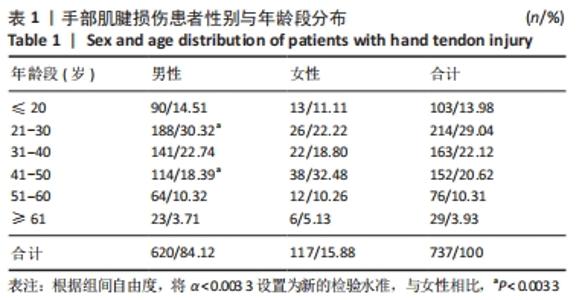
2.3 年龄及性别分布 纳入患者的年龄分布范围为2-82岁,平均年龄(35.02±13.69)岁,中位数年龄为34岁;其中男620例,占总调查对象的84.1%,年龄2-82岁,平均(34.50±13.71)岁;女性117例,占总调查对象的15.9%,年龄5-76岁,平均(37.75±13.34)岁。经Wilcoxno秩和检验,Z=-2.600,P=0.009 < 0.05,男女年龄具有可比性,男性比例明显高于女性(5.30∶1)。患者年龄分布差异有显著性意义(χ2=13.711,P < 0.05),其中肌腱损伤患者多发生于21-30岁之间,占总例数的29.0%;而年龄≥61岁的人群发生肌腱损伤的例数最少,为29例,仅占总例数的3.9%,见表1。"
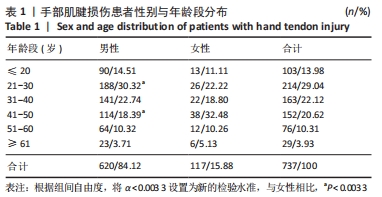
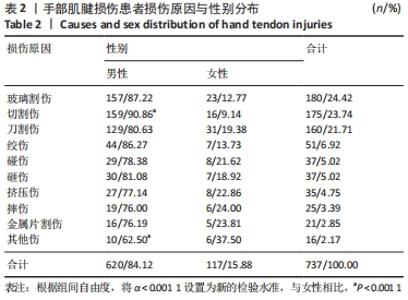
2.4 损伤原因分布 根据致伤种类的不同,将损伤原因分类为“玻璃割伤” “切割伤” “刀割伤” “绞伤” “碰伤” “砸伤” “挤压伤” “摔伤” “金属片割伤” “其他(烧灼伤、咬伤、车祸、刺伤)”。其中,“切割伤”为动力性机械工具所致的损伤,如切割机、电锯、收割机等;“刀割伤”为无动力性锐器工具所致的损伤,如生活性各类刀具等。所有损伤原因中,玻璃割伤病例数最多,为180例(24.4%);其次为切割伤,为175例(23.7%);再次为刀割伤,为160例(21.7%)。 2.4.1 性别与损伤原因分布 将损伤原因按性别不同统计,在所有损伤原因中男性均高于女性,统计结果显示,损伤原因分布与性别差异有显著性意义(χ2=19.153,P < 0.05)。应用2分割进行组间两两比较,将α < 0.001 1设置为新的检验水准,结果显示,不同性别间切割伤、其他伤相比差异有显著性意义(P < 0.001 1),在切割伤中,男性容易造成手部肌腱的损伤,见表2。"
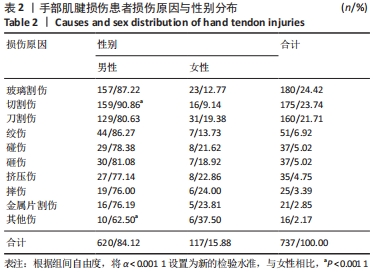
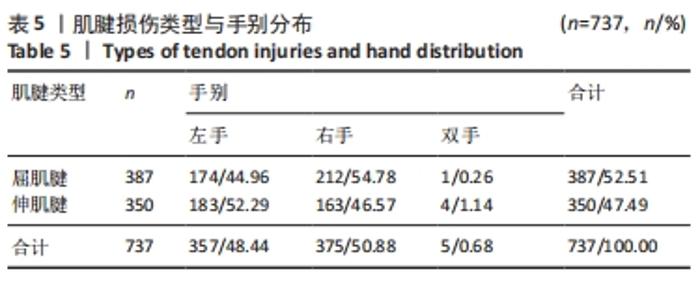
2.5.2 年份与季节分布 按季节分布春季(3-5月),夏季(6-8月),秋季(9-11月),冬季(12月-次年2月),统计结果见表4。四季患者的构成比为16.2%-42.3%,夏季占比最高,为42.3%,春季占比最低,为16.2%,统计结果提示,各年份的季节分布差异有显著性意义(χ2=38.378,P < 0.05),夏季损伤例数明显多于其他季节,占42.3%。 2.6 受伤情况 2.6.1 屈伸指肌腱损伤的手别分布 此次研究调查的结果显示,患者中屈、伸指肌腱的手别分布差异有显著性意义(Fisher值=6.433,P < 0.05),其中屈肌腱损伤的比例高于伸肌腱,占比为52.51%;在屈肌腱损伤中多发生于右手,在伸肌腱损伤中多发生于左手,在发生手部肌腱损伤时,右手损伤的比例高于左手,见表5。"
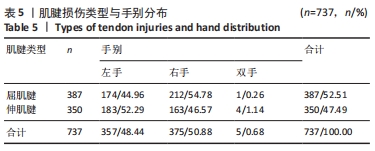
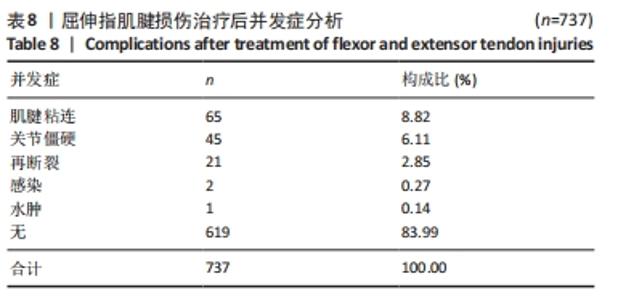
对手部肌腱损伤的合并症进行χ2检验,统计结果显示,手部肌腱损伤的合并症分布差异均有显著性意义(P < 0.05)。伸指肌腱损伤合并有骨折的患者明显多于屈指肌腱损伤的患者,因此在伸指肌腱损伤时更容易发生手部的骨折;屈指肌腱损伤合并有神经、血管损伤的患者明显多于伸指肌腱损伤的患者,在屈指肌腱损伤时更容易造成神经、血管的损伤;手部肌腱损伤中感染的患者明显多于无感染的患者(P < 0.05)。 2.8 治疗效果分析 2.8.1 屈伸指肌腱损伤治疗后并发症的分布 调查结果见表8所示,屈伸指肌腱损伤治疗后主要并发症为肌腱粘连、关节僵硬、再断裂、感染、水肿,在737例屈伸指肌腱损伤患者中,发生肌腱粘连65例,占8.82%;关节僵硬45例,占6.11%;再断裂21例,占2.85%;感染2例,占0.27%;水肿1例,占0.14%。 "
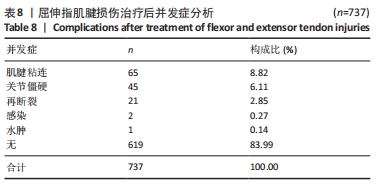
| [1] LEE JS, KIM YH. Factors associated with limited hand motion after hand trauma. Medicine (Baltimore). 2019;98(3):e14183. [2] THANGAVELU M, VEERASAMY N, KANTHAN A. Study on evaluation and management of hand injuries. J Evol Med Dent Sci. 2016;5(66):4703-4707. [3] POLINDER S, IORDENS GI, PANNEMAN MJ, et al. Trends in incidence and costs of injuries to the shoulder, arm and wrist in The Netherlands between 1986 and 2008. BMC Public Health. 2013;13:531. [4] 强力, 薛明宇, 卜凡玉, 等. 游离腕横纹嵌合皮瓣修复手指复合组织缺损八例[J]. 中华显微外科杂志,2017,40(4):371-373. [5] 李红斌. 手部指屈肌腱损伤修复治疗的临床观察[J]. 中外医学研究, 2018,16(34):131-133. [6] 夏尚, 李鑫, 潘艳丽, 等. 手部指屈肌腱损伤修复治疗的临床分析[J]. 中外医学研究,2017,15(31):69-70. [7] 高君, 王维, 那磊, 等. 肌腱粘连的预防:现状和进展[J]. 中国组织工程研究,2014,18(46):7515-7519. [8] MOLLOY T, WANG Y, MURRELL G. The roles of growth factors in tendon and ligament healing. Sports Med. 2003;33(5):381-394. [9] HUNTER JM, SALISBURY RE. Flexor-tendon reconstruction in severely damaged hands. A two-stage procedure using a silicone-dacron reinforced gliding prosthesis prior to tendon grafting. J Bone Joint Surg Am. 1971;53(5):829-858. [10] RIGO IZ, ROKKUM M. Predictors of outcome after primary flexor tendon repair in zone 1, 2 and 3. J Hand Surg Eur. 2016;41(8):793-801. [11] LILLY SI, MESSER TM. Complications after treatment of flexor tendon injuries. J Am Acad Orthop Surg. 2006;14(7):387-396. [12] TANG JB. Clinical outcomes associated with flexor tendon repair. Hand Clin. 2005;21(2):199-210. [13] AMADIO P, AN KN, EJESKAR A, et al. IFSSH Flexor Tendon Committee report. J Hand Surg Br. 2005;30(1):100-116. [14] 汤锦波. 手屈指肌腱损伤的临床修复效果[J]. 中华创伤骨科杂志, 2006,8(1):8-12. [15] DE JONG JP, NGUYEN JT, SONNEMA AJ, et al. The incidence of acute traumatic tendon injuries in the hand and wrist: a 10-year population-based study. Clin Orthop Surg. 2014;6(2):196-202. [16] GIUSTINI M, DE LEO A, LETI ACCIARO A, et al. Incidence estimates of hand and upper extremity injuries in Italy. Ann Ist Super Sanita. 2015; 51(4):305-312. [17] CHANG MK, TAY SC. Flexor Tendon Injuries and Repairs: A Single Centre Experience. J Hand Surg Asian Pac. 2018;23(4):487-495. [18] 胡朝阳, 刘鸣江. 手外伤流行病学研究现状[J]. 现代医药卫生, 2014,30(23):3568-3570. [19] 刘士波, 孙勃, 李小东,等. 某三甲医院手外伤病因与发病特点的调查分析[J]. 世界最新医学信息文摘,2018,18(43):253-255. [20] 福嘉欣, 江毅, 朱红,等. 673例成人职业性手外伤的流行病学调查[J]. 中华劳动卫生职业病杂志,2015,33(10):769-770. [21] KASKUTAS V, POWELL R. The impact of flexor tendon rehabilitation restrictions on individuals’ independence with daily activities: implications for hand therapists. J Hand Ther. 2013;26(1):22-28; quiz 29. [22] RAMEL E, ROSBERG HE, DAHLIN LB, et al. Return to work after a serious hand injury. Work. 2013;44(4):459-469. [23] DOCHEVA D, MULLER SA, MAJEWSKI M, et al. Biologics for tendon repair. Adv Drug Deliv Rev. 2015;84:222-239. [24] 江克罗, 张文正, 黎小艇, 等. 掌背动脉顺行皮瓣修复手背皮肤软组织缺损的临床应用[J]. 中华手外科杂志,2018,34(5):385-386. [25] 詹宏钢, 汤样华, 徐灿达,等. 复合组织瓣移植修复伴有伸肌腱缺损的指背软组织缺损创面[J]. 中华手外科杂志,2020,36(3):238-240. [26] 常红, 安晓飞, 王辉, 等. 多类型桡动脉掌浅支腕横纹部游离皮瓣在手指复合软组织缺损治疗中的应用研究[J]. 中华骨与关节外科杂志,2021,14(8):688-692. [27] 杜冬, 庄永青, 傅小宽, 等. 手部屈肌腱损伤的早期显微外科修复[J]. 中华手外科杂志,2003,19(1):53. [28] CALISKAN UCKUN A, YURDAKUL FG, ERGANI HM, et al. Factors predicting reoperation after hand flexor tendon repair. Ulus Travma Acil Cerrahi Derg. 2020;26(1):115-122. [29] GOJOWY D, HOMANN HH, SCHREIER D. [Flexor tendon injuries of the hand]. Chirurg. 2020;91(10):895-902. [30] KLIFTO CS, BOOKMAN J, PAKSIMA N. Postsurgical Rehabilitation of Flexor Tendon Injuries. J Hand Surg Am. 2019;44(8):680-686. [31] 杜传林, 李朋, 杨广友, 等. 手Ⅱ区屈肌腱损伤修复及康复治疗的临床观察[J]. 解放军医学杂志,2014,39(12):1008-1009. [32] AKBARI H, RAHIMI AA, GHAVAMI Y, et al. Effect of Heparin on Post-Operative Adhesion in Flexor Tendon Surgery of the Hand. J Hand Microsurg. 2015;7(2):244-249. [33] WU YF, TANG JB. Effects of tension across the tendon repair site on tendon gap and ultimate strength. J Hand Surg Am. 2012;37(5):906-912. [34] 李春江. 埋入式双套索锁扣结错位缝合法修复Ⅱ区指屈肌腱损伤[J]. 中华手外科杂志,2016,32(1):22-24. [35] 胡利, 叶红梅, 黄晓瑜, 等. 手部肌腱损伤病人手术护理及功能锻炼[J]. 牡丹江医学院学报,2016,37(4):136-137. [36] STAUBER T, BLACHE U, SNEDEKER JG. Tendon tissue microdamage and the limits of intrinsic repair. Matrix Biol. 2020;85-86:68-79. [37] KOEHLER SV, SAUERBIER M, TERZIS A. Rupture Rate, Functional Outcome and Patient Satisfaction after Primary Flexor Tendon Repair with the Modified 4-Strand Core Suture Technique by Tsuge and Using the Arthrex FiberLoop((R)) with Early Motion Rehabilitation. J Clin Med. 2021;10(19):4538. [38] 石金柱, 马学忠, 朱亚斌, 等. Ishiguro法治疗伸肌腱止点开放性骨折[J]. 实用手外科杂志,2018,32(4):437-438. [39] 杜启军,梁王班. 显微外科技术配合中药熏洗治疗肌腱损伤对肌腱粘连的预防作用[J]. 中医临床研究,2015,7(21):104-105. [40] 刘伟. Ⅱ区指屈肌腱损伤患者在修复术后实施虚拟情景反馈训练对手功能的恢复作用[J]. 创伤外科杂志,2018,20(6):443-445. [41] 姜大伟,贾全章,侯明晓,等. 伸指肌腱损伤后交指样显微编织缝合术加玻璃酸钠防粘连治疗的实验研究[J]. 中国矫形外科杂志, 2009,17(14): 1090-1092. [42] MANNINEN M, KARJALAINEN T, MÄÄTTÄ J, et al. Epidemiology of Flexor Tendon Injuries of the Hand in a Northern Finnish Population. Scand J Surg. 2017;106(3):278-282. [43] MICHEL PA, KRONENBERG D, NEU G, et al. Microsurgical reconstruction affects the outcome in a translational mouse model for Achilles tendon healing. J Orthop Translat. 2020;24:1-11. [44] NEUWIRTH M, BÜRGER H, PALLE W, et al. One-stage reconstruction of isolated and combined tendon defects with the vascularized adductor magnus tendon graft: Surgical technique and preliminary results. J Plast Reconstr Aesthet Surg. 2016;69(7):928-935. [45] TANG Y, LI Y. Effectiveness of microsurgical repair of flexor tendon rupture by non-knot Kessler suture method in anastomotic stoma]. Zhongguo Xiu Fu Chong Jian Wai Ke Za Zhi. 2011;25(10):1210-1213. [46] KREY D, BORCHERS J, MCCAMEY K. Tendon needling for treatment of tendinopathy: A systematic review. Phys Sportsmed. 2015;43(1):80-86. [47] DY CJ, HERNANDEZ-SORIA A, MA Y, et al. Complications after flexor tendon repair: a systematic review and meta-analysis. J Hand Surg Am. 2012;37(3): 543-551.e541. [48] FUJIHARA Y, OTA H, WATANABE K. Utility of early active motion for flexor tendon repair with concomitant injuries: A multivariate analysis. Injury. 2018;49(12):2248-2251. [49] BIGORRE N, DELAQUAIZE F, DEGEZ F, et al. Primary flexor tendons repair in zone 2: Current trends with GEMMSOR survey results. Hand Surg Rehabil. 2018;37(5):281-288. [50] MORIYA K, YOSHIZU T, MAKI Y, et al. Clinical outcomes of early active mobilization following flexor tendon repair using the six-strand technique: short- and long-term evaluations. J Hand Surg Eur. 2015; 40(3):250-258. |
| [1] | Li Yuqiao, Sun Tianwei, Ma Bin, Zhou Zhaohong, Dong Runbei, Wu Haiyang. A comparative study of imaging parameters and quality of life scores between subtypes of lumbar spondylolisthesis [J]. Chinese Journal of Tissue Engineering Research, 2022, 26(6): 943-948. |
| [2] | Gou Yongsheng, Ding Keyuan, Xu Shengqian, Li Haibo, Zhong Gang, Li Liang, Teng Lin. Comparison of double Kirschner wire with double screw fixation in the treatment of avulsion fracture at the base of the distal phalanx [J]. Chinese Journal of Tissue Engineering Research, 2022, 26(18): 2849-2853. |
| [3] | Liao Yingying, Zhang Xin, Wen Chenghong, Chen Ke, Zhou Hui, Gou Qingchun. Animal models of knee joint stiffness: modeling methods and characteristics [J]. Chinese Journal of Tissue Engineering Research, 2022, 26(15): 2439-2445. |
| [4] | Wang Haiying, Lü Bing, Li Hui, Wang Shunyi. Posterior lumbar interbody fusion for degenerative lumbar spondylolisthesis: prediction of functional prognosis of patients based on spinopelvic parameters [J]. Chinese Journal of Tissue Engineering Research, 2021, 25(9): 1393-1397. |
| [5] | Zhao Guoyuan, Hu Weijian, Guo Siyin, Wei Hewei, Wan Lei, Zheng Weipeng, Liu Zhijun, Liao Zhihao, Chen Sheng. Meta-analysis of hyaluronic acid in the treatment of rotator cuff injury [J]. Chinese Journal of Tissue Engineering Research, 2021, 25(28): 4573-4579. |
| [6] | Hu Jing, Xiang Yang, Ye Chuan, Han Ziji. Three-dimensional printing assisted screw placement and freehand pedicle screw fixation in the treatment of thoracolumbar fractures: 1-year follow-up [J]. Chinese Journal of Tissue Engineering Research, 2021, 25(24): 3804-3809. |
| [7] | Liu Gang, Yang Qiang, Hao Yonghong, Deng Shucai. Advantages and significance of S2 alar iliac screw fixation in sacropelvic fixation [J]. Chinese Journal of Tissue Engineering Research, 2021, 25(21): 3395-3400. |
| [8] | Feng Yong, Zhao Yanxu, Zhang Minze. Human amniotic membrane, drugs, and growth factors prevent adhesion after repair of tendon injury [J]. Chinese Journal of Tissue Engineering Research, 2020, 24(4): 625-630. |
| [9] | Hou Haisheng, Yang Li, Yan Xiaowei. Efficacy of 3D Max mesh versus common mesh for laparoscopic inguinal hernia repair [J]. Chinese Journal of Tissue Engineering Research, 2020, 24(28): 4588-4592. |
| [10] | Li Qingsong, Liu Shaoyu, Yin Zongsheng. Multiple posterior lumbar interbody fusion and posterolateral fusion instrumentation for thoracolumbar kyphosis and osteoporotic fracture in older adults [J]. Chinese Journal of Tissue Engineering Research, 2019, 23(4): 512-517. |
| [11] | Zhong Qiusheng, Xia Weichao, Guo Meizhen, Zhu Haiqing, Zhong Cuiqiong, Shao Jieqi, He Xiaohong, Chen Xiumin. Sandwiched Moxibustion plus Bushen Quhan recipe for treating knee osteoarthritis: a randomized controlled trial [J]. Chinese Journal of Tissue Engineering Research, 2019, 23(35): 5670-5675. |
| [12] | Mo Fan1, Zhao Jinmin2, Sha Ke2, Yang Yuan1, Huang Weifeng1, Wei Wu1, Xie Qi1. Treatment and research progress of adult brachial plexus injury [J]. Chinese Journal of Tissue Engineering Research, 2019, 23(31): 5072-5078. |
| [13] | Wang Haonan, Wang Jihong, Wen Shuzheng. Platelet-rich plasma: its application in the repair of tendon and ligament injuries [J]. Chinese Journal of Tissue Engineering Research, 2019, 23(30): 4875-4881. |
| [14] | Song Jinglin. Knee joint isokinetic strength of female volleyball players at different ages [J]. Chinese Journal of Tissue Engineering Research, 2019, 23(27): 4321-4325. |
| [15] | Zeng Lingfeng1, 2, 3, Yang Weiyi1, Liang Guihong1, 3, Chen Hongyun1, Guo Da1, Luo Minghui1, Pan Jianke1, Zhao Di2, Zhao Jinlong2, . Systematic review on the efficacy and safety of Tai Chi of traditional body refreshment for improving bone mineral density loss [J]. Chinese Journal of Tissue Engineering Research, 2019, 23(27): 4420-4428. |
| Viewed | ||||||
|
Full text |
|
|||||
|
Abstract |
|
|||||
